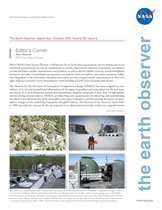The Earth Observer has a new look! Visit the NEW Earth Observer website.
The Earth Observer: Sep - Oct, 2016
In This Issue
Click title below to view page
- Editor’s CornerFront Cover
- Feature Article
- The Network for the Detection of Atmospheric Composition Change: 25 Years Old and Going Strong4
- NASA’s Science Program Support Office Partners with the U.S. Department of State on Outreach16
- Meeting/Workshop Summaries
- Surface Water and Ocean Topography Science Team18
- Summary of the Spring 2016 NASA Land-Cover Land-Use Change Science Team Meeting24
- 2016 CLARREO Science Definition Team Meeting Summary30
- In The News
- NASA Releases First Map of Thawed Areas under Greenland’s Ice Sheet35
- NASA Flies to Africa to Study Climate Effects of Smoke on Clouds36
- Arctic Sea Ice Annual Minimum Ties Second Lowest on Record38
- Kudos and Announcement
- Two NASA Earth Scientists Among the 2016 Class of AGU Fellows29
- Storytelling and More: NASA Science at the 2016 AGU Fall Meeting39
- Regular Features
- NASA Earth Science in the News40
- NASA Science Mission Directorate – Science Education and Public Outreach Update42
- Science Calendars43
Editor’s Corner
Steve Platnick
EOS Senior Project Scientist
While NASA’s Earth Science Division is well-known for its Earth-observing missions, remote sensing and in situ suborbital measurements are critical complements to satellite observations. Airborne instruments can simulate current and future satellite measurements and products, as well as directly validate remotely sensed atmospheric parameter retrievals. Ground-based measurements are used for both atmospheric and surface parameter validation. Regardless of the motivation, suborbital instruments provide...
Read more...

